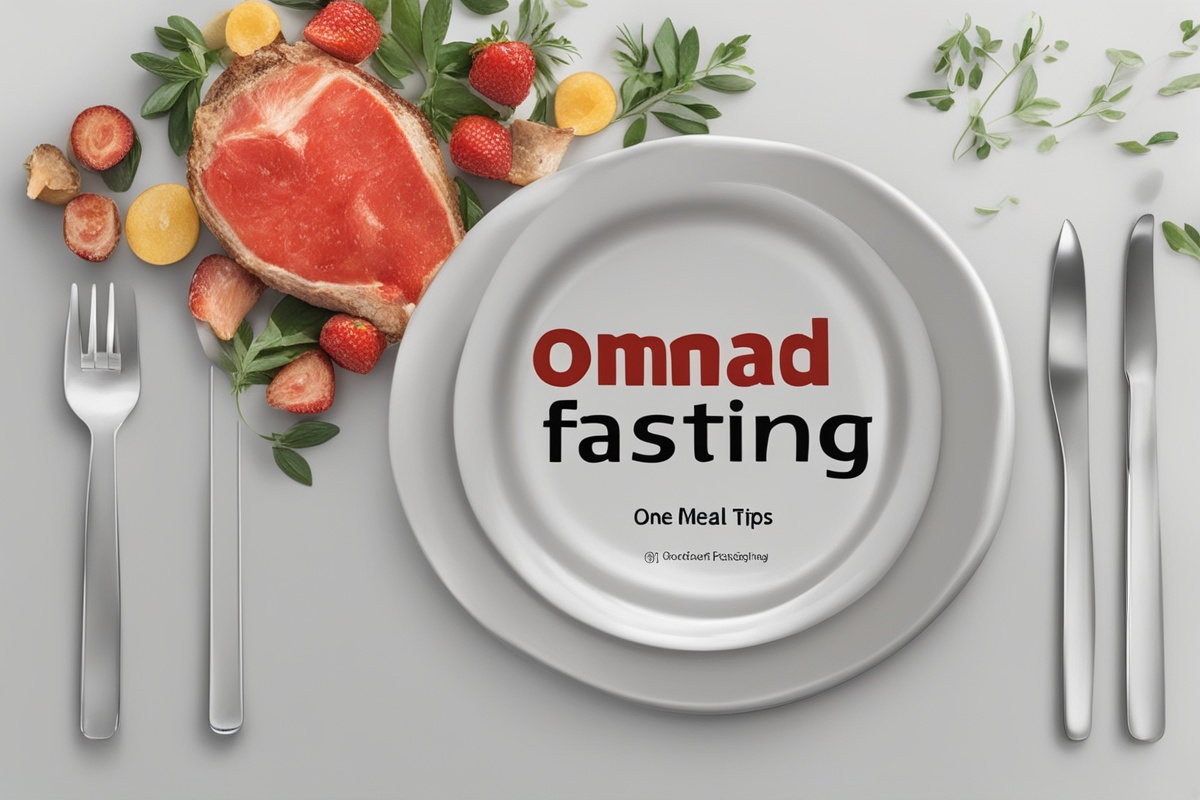Have you ever considered eating just one meal a day to boost your health, shed extra pounds, or simplify your life? If so, you’ve likely stumbled across OMAD fasting, a powerful intermittent fasting approach that’s gaining traction among health enthusiasts. Short for “One Meal a Day,” OMAD is more than just a diet—it’s a lifestyle shift that promises benefits like weight loss, improved metabolic health, and mental clarity. But is it right for you? In this comprehensive guide, I’ll walk you through what OMAD fasting entails, the science behind it, practical tips to make it work, and potential pitfalls to avoid. Let’s dive into this unique fasting method and explore how it might fit into your wellness journey.
What Is OMAD Fasting?
At its core, OMAD fasting is a form of intermittent fasting where you consume all your daily calories in a single meal, typically within a one-hour eating window. For the remaining 23 hours, you fast, consuming only water, black coffee, or unsweetened tea. Unlike other fasting protocols like the 16:8 method (16 hours fasting, 8 hours eating), OMAD takes restriction to the next level by condensing your food intake into one sitting. This approach isn’t new—historically, many cultures and individuals, from ancient warriors to religious practitioners, have eaten sparingly or in single meals for practical or spiritual reasons. Today, OMAD is often adopted for health benefits, with proponents claiming it can help with weight management and metabolic flexibility.
The Science Behind OMAD Fasting: What Does Research Say?
While OMAD fasting hasn’t been studied as extensively as other intermittent fasting methods, emerging research and related studies on fasting provide insight into its potential benefits. One of the primary mechanisms behind OMAD is its ability to promote ketosis, a metabolic state where your body burns fat for fuel instead of glucose. During extended fasting periods, insulin levels drop, and the body taps into stored fat for energy (Mattson et al., 2017). Additionally, fasting for 23 hours can enhance autophagy, a cellular “clean-up” process that may protect against aging and disease (Mizushima & Komatsu, 2011).
Beyond fat-burning, OMAD may improve insulin sensitivity and blood sugar control, which are critical for preventing type 2 diabetes. A study on intermittent fasting showed that time-restricted eating could reduce fasting glucose levels and improve metabolic markers (Sutton et al., 2018). While direct OMAD studies are limited, these findings suggest that eating one meal a day could offer similar advantages. However, it’s worth noting that long-term data on OMAD specifically is sparse, and more research is needed to confirm its safety and efficacy for diverse populations.
Benefits of OMAD Fasting for Health and Lifestyle
So, why are so many people raving about omad fasting? Let’s break down some of the most commonly reported benefits, backed by science and anecdotal evidence. First, weight loss is often a major motivator. By limiting your eating window, you naturally reduce calorie intake, making it easier to maintain a deficit (Tinsley & La Bounty, 2015). Plus, the extended fasting period can curb cravings over time as your body adjusts to fewer meals. Many OMAD followers also report increased mental clarity—likely due to stable blood sugar levels and the absence of frequent eating spikes.
Another perk is simplicity. With only one meal to plan, prep, and eat, you save time and mental energy. This can be a game-changer for busy folks who struggle with meal planning or constant snacking. On the health front, preliminary research suggests that time-restricted eating like OMAD may support cardiovascular health by reducing blood pressure and inflammation markers (Wilkinson et al., 2020). While these benefits sound promising, they’re not guaranteed for everyone, and individual results can vary widely based on lifestyle, starting health, and adherence.
- Weight Loss: Easier calorie restriction and fat-burning through ketosis.
- Mental Clarity: Fewer blood sugar fluctuations can enhance focus.
- Time Efficiency: Less time spent on cooking and eating frees up your day.
- Metabolic Health: Potential improvements in insulin sensitivity and blood sugar control.
Challenges and Risks of OMAD Fasting
Before you jump into OMAD fasting, it’s important to understand the hurdles and risks. For starters, eating just one meal a day can be tough, especially if you’re used to multiple meals or snacks. Hunger pangs, irritability, and fatigue are common in the early days as your body adjusts. There’s also the risk of nutrient deficiencies if your single meal isn’t well-balanced—getting enough vitamins, minerals, and protein in one sitting takes careful planning. Some studies on extreme fasting warn of potential muscle loss if protein intake or exercise isn’t prioritized (Phillips & Van Loon, 2011).
Socially, OMAD can be isolating. Skipping breakfast with family or lunch with coworkers might feel awkward, and dining out becomes trickier when you’re limited to one meal. For certain groups—pregnant women, individuals with eating disorders, or those with medical conditions like diabetes—OMAD may be unsafe without medical supervision. Always consult a healthcare provider before starting any extreme fasting regimen to ensure it aligns with your health needs.
How to Start OMAD Fasting: Practical Tips for Success
Ready to give OMAD fasting a try? Ease into it with a thoughtful approach to avoid burnout or health issues. First, transition gradually. If you’re new to fasting, start with a 16:8 schedule for a few weeks before shrinking your eating window to one hour. Choose a meal time that suits your lifestyle—some prefer dinner to enjoy a social meal, while others opt for lunch to fuel midday energy. Hydration is key during the fasting window; sip water throughout the day to stave off hunger and support your body’s processes.
When crafting your one meal, prioritize nutrient density. Include lean protein, healthy fats, and plenty of vegetables to meet your nutritional needs. Avoid overloading on processed carbs or sugars, as they can cause energy crashes post-meal. Lastly, listen to your body. If you feel dizzy, overly fatigued, or unwell, take a break and reassess. OMAD isn’t a one-size-fits-all solution, and flexibility is crucial for long-term success.
- Start Slow: Build up to OMAD by trying shorter fasting windows first.
- Stay Hydrated: Drink water, black coffee, or tea during fasting hours.
- Balance Your Meal: Focus on protein, fats, and veggies for satiety and nutrition.
- Pick the Right Time: Align your meal with your energy or social needs.
- Monitor Symptoms: Stop if you experience severe discomfort or health issues.
Who Should Avoid OMAD Fasting?
While OMAD fasting can be transformative for some, it’s not suitable for everyone. Certain individuals should steer clear or seek medical advice before attempting it. Pregnant or breastfeeding women need consistent nutrition for themselves and their babies, making extreme fasting risky. People with a history of eating disorders may find OMAD triggering, as it can reinforce unhealthy food relationships. Those with chronic conditions like diabetes or hypoglycemia should be cautious, as prolonged fasting can destabilize blood sugar levels. If you’re on medication that requires food intake or have any doubts, a conversation with your doctor is non-negotiable. Health always comes first, and there are plenty of other wellness strategies to explore if OMAD isn’t a fit.
In wrapping up, OMAD fasting offers an intriguing path for those seeking weight loss, metabolic benefits, or a simpler approach to eating. It’s not without challenges, though—hunger, social constraints, and nutritional balance require careful attention. By starting slow, planning nutrient-rich meals, and listening to your body, you can test whether one meal a day aligns with your goals. Remember, fasting is deeply personal; what works for one person may not for another. If you’re curious about OMAD, approach it with an open mind and a commitment to your well-being. Have you tried OMAD or another fasting method? I’d love to hear your thoughts in the comments below!
References
- Mattson, M. P., Longo, V. D., & Harvie, M. (2017). Impact of intermittent fasting on health and disease processes. Ageing Research Reviews, 39, 46–58. https://doi.org/10.1016/j.arr.2016.10.005
- Mizushima, N., & Komatsu, M. (2011). Autophagy: Renovation of cells and tissues. Cell, 147(4), 728–741. https://doi.org/10.1016/j.cell.2011.10.026
- Phillips, S. M., & Van Loon, L. J. (2011). Dietary protein for athletes: From requirements to optimum adaptation. Journal of Sports Sciences, 29(Suppl 1), S29–S38. https://doi.org/10.1080/02640414.2011.619204
- Sutton, E. F., Beyl, R., Early, K. S., Cefalu, W. T., Ravussin, E., & Peterson, C. M. (2018). Early time-restricted feeding improves insulin sensitivity, blood pressure, and oxidative stress even without weight loss in men with prediabetes. Cell Metabolism, 27(6), 1212–1221. https://doi.org/10.1016/j.cmet.2018.04.010
- Tinsley, G. M., & La Bounty, P. M. (2015). Effects of intermittent fasting on body composition and clinical health markers in humans. Nutrition Reviews, 73(10), 661–674. https://doi.org/10.1093/nutrit/nuv041
- Wilkinson, M. J., Manoogian, E. N. C., Zadourian, A., Lo, H., Fakhouri, S., Shoghi, A., … & Panda, S. (2020). Ten-hour time-restricted eating reduces weight, blood pressure, and atherogenic lipids in patients with metabolic syndrome. Cell Metabolism, 31(1), 92–104. https://doi.org/10.1016/j.cmet.2019.11.004






